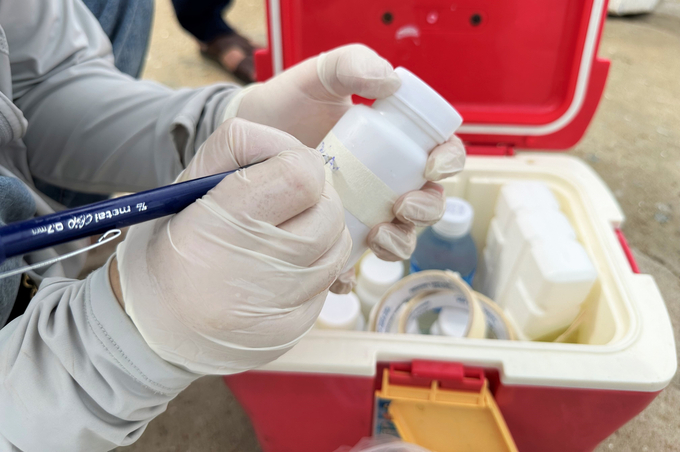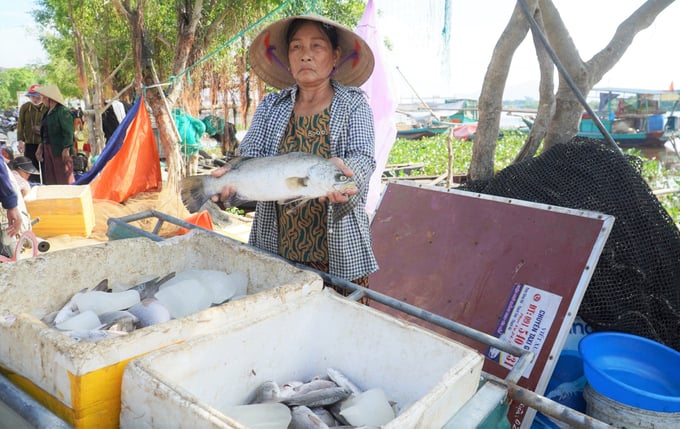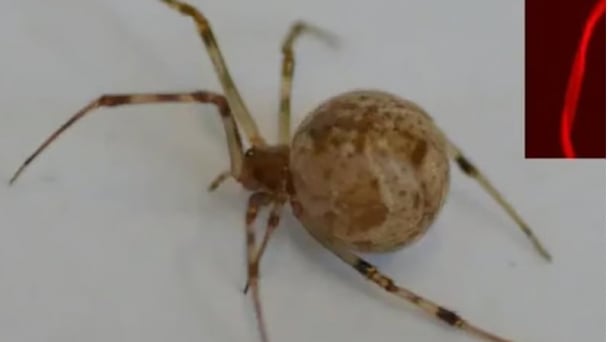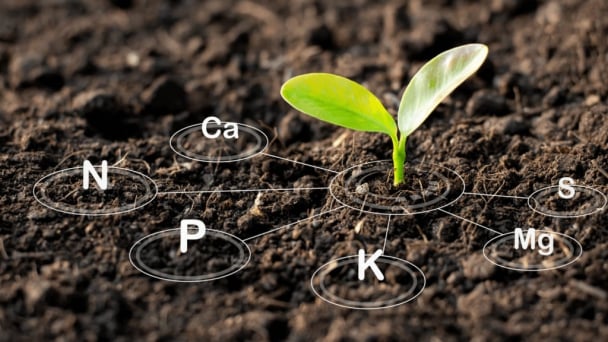May 21, 2025 | 04:38 GMT +7
May 21, 2025 | 04:38 GMT +7
Hotline: 0913.378.918
May 21, 2025 | 04:38 GMT +7
Hotline: 0913.378.918
Although the area for aquaculture of Ha Tinh province in 2023 is only equal to the same period in 2022, reaching more than 7,400 ha, the output increases by more than 3.5%, reaching 16,800 tons.
The targets on productivity, output of freshwater and brackish water aquaculture, production and nursery of aquatic breeds have all been met and exceeded the targets set by the provincial People's Committee. These numbers demonstrate the effectiveness of the "revolution" in applying scientific and technical advances to aquaculture as well as proactively implementing measures to protect the environment and prevent epidemics.

Thanks to specialized agencies carrying out activities such as sample collection, monitoring, and early warning of diseases and environmental issues, local farmers can minimize risks in the production process. Photo: Thanh Nga.
"We often tell farmers that ensuring a stable water environment plays an extremely important role in the production cycle. Periodically before stocking seasons, the Sub-department will coordinate with functional units to monitor water samples as well as the environment of farming areas to recommend to people environmental management measures, thus preventing and minimizing risks in the production process,” Nguyen Thi Hoai Thuy, Head of Aquaculture Division (Ha Tinh Sub-Department of Fisheries) said.
This year, Ha Tinh Sub-Department of Fisheries has organized sampling and environmental inspection in 7 concentrated shrimp farming areas in 7 coastal districts, towns and Ha Tinh city. The Sub-department also worked with the Northern Center for Environmental Monitoring and Aquatic Diseases - Research Institute Aquaculture No.1 (RIA1) to take samples, monitor the environment and diseases in 3 shrimp farming areas mainly in the form of extensive farming and improved extensive farming.
Working alongside the Sub-department of Fisheries, the unit directly responsible for disease management, the Sub-department of Livestock Production and Animal Health also carries out proactive disease surveillance, especially at the beginning of the spring - summer crop and after the heavy rain season. The goal is to provide early warning and guide farmers to apply prevention and control measures.

Whether the warning is effective or not requires the coordination and compliance of farmers. Photo: Thanh Nga.
On the other hand, the Sub-department of Livestock Production and Animal Health plans to consult and submit a proposal to Central about supporting Ha Tinh with 35 tons of Chlorine from the national reserve and allocating resources to localities to deploy aquatic disease prevention.
In case of spotting dead aquatic products, the Sub-Department coordinates with local authorities to promptly inspect, collect samples, diagnose the disease, supply chemicals, and provide technical guidance on disease treatment.
This year's outbreaks are detected early and handled promptly, preventing them from spreading on a large scale. Leaders of Ha Tinh Sub-department of Livestock Production and Animal Health believe that epidemics mainly occur in farmed shrimp and molluscs at present, while fish often suffer from water shock due to sudden changes in indicators.
In areas where warnings about disease, environmental and weather risks are well received before the production season, farmers can limit risks in the farming process and vice versa. Nevertheless, timely recommendations must go hand in hand with the farmer’s sense of compliance with instructions.
“In early October 2023, approximately 50 tons of seabass raised in cages on Nghen River, Thach Son commune, Thach Ha district suddenly died overnight, causing billions of VND in damage to dozens of households. The problem worth discussing is that the professional sector and the commune government had previously given out warnings and urged farmers to harvest to avoid floods, but they did not do so, leading to unfortunate losses,” said a leader of Ha Tinh Sub-Department of Fisheries.

In the long term, on the path of sustainable aquaculture development, farmers need to invest in intensive farming and high-tech farming models to effectively control diseases. Photo: Thanh Nga.
During the last months of the year, the weather in Ha Tinh is unfavorable for aquaculture activities, so most farming areas only stock fish to protect ponds and lakes. Particularly in some outdoor shrimp farming areas, people focus on cleaning and disinfecting ponds to prepare for the spring - summer crop in 2024.
Ha Tinh Sub-department of Livestock Production and Animal Health recommends that in the long term, localities need to review and methodically evaluate the effectiveness of shrimp farming areas to gradually convert to intensive farming and high-tech intensive farming models. As for extensive farming areas, people should take more responsibility and supervise thoroughly to limit epidemics and apply intercropping with mullet, tilapia, and rabbitfish to clean impurities and disease vectors.
Translated by Samuel Pham

(VAN) Japan's grant aid project contributes to capacity building, promoting organic agricultural production, and fostering sustainable community development in Dong Thap province.

(VAN) For years, the CRISPR-Cas9 genome technology has been reshaping genetic engineering, a precision tool to transform everything from agriculture to medicine.

(VAN) Vietnam aims to become a 'leader' in the region in the capacity and managing effectively soil health and crop nutrition.
![Reducing emissions from rice fields: [Part 1] Farming clean rice together](https://t.ex-cdn.com/nongnghiepmoitruong.vn/608w/files/news/2025/05/05/z6509661417740_a647202949c539012a959e841c03e1d3-nongnghiep-143611.jpg)
(VAN) Growing clean rice helps reduce environmental pollution while increasing income, allowing farmers to feel secure in production and remain committed to their fields for the long term.
/2025/05/19/5136-1-144800_230.jpg)
(VAN) The Nghe An Provincial People's Committee has just approved the list of beneficiaries eligible for revenue from the Emission Reductions Payment Agreement (ERPA) in the North Central region for the year 2025.

(VAN) 14 out of 35 domesticated elephants in Dak Lak province have had their living conditions improved, with 11 of them currently participating in the non-riding elephant tourism model.

(VAN) Muong Nhe Nature Reserve hopes that being upgraded to a national park will lay the foundation for forest protection efforts to be carried out in a systematic, modern, and sustainable manner.